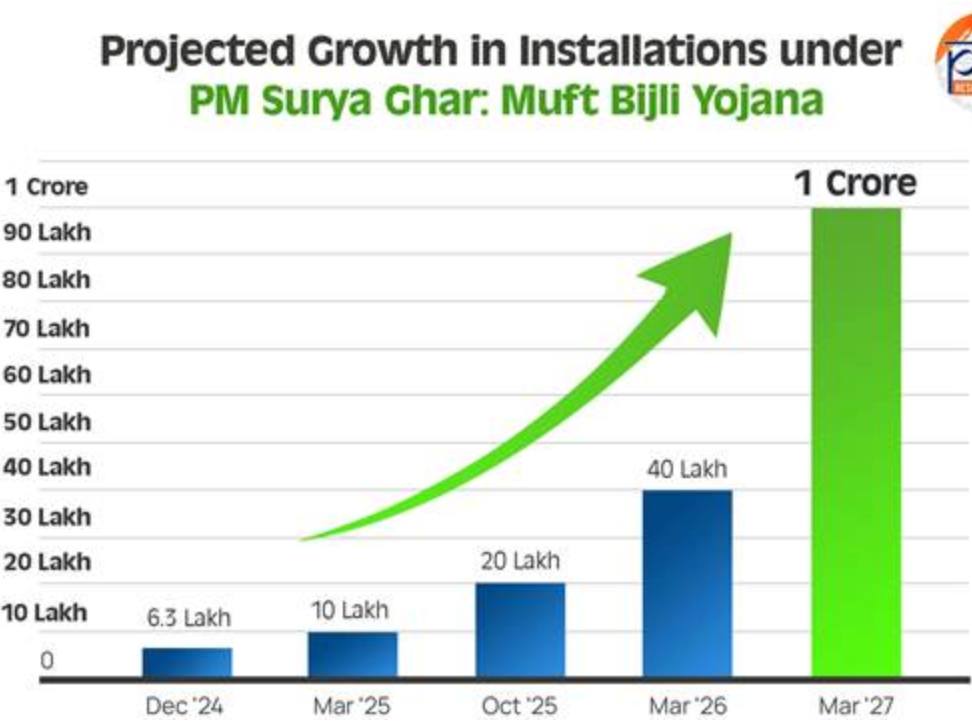Syllabus: GS2/Government Policy and Intervention; GS3/Energy
Context
- Recently, the Union Minister for New and Renewable Energy announced that the PM Surya Ghar scheme has achieved a milestone with 8.5 lakh households (about 8.5%) installing rooftop solar connections.
About the PM Surya Ghar: Muft Bijli Yojana
- About: It is a centrally sponsored scheme aimed at providing free electricity to households by subsidizing the installation of rooftop solar panels.
- Launch & Ministry: February 15, 2024 by the Ministry for New and Renewable Energy (MNRE).
- Aim: Provide up to 300 units of free electricity per month to one crore households.
- Lower electricity expenses for both households and the government.
- Increase the share of renewable energy in India’s energy mix.
- Reduce carbon emissions and promote sustainable development.

- Key Features:
- Subsidies and Incentives: The scheme provides for a subsidy of 60% of the solar unit cost for systems up to 2kW capacity and 40 percent of additional system cost for systems between 2 to 3kW capacity. The subsidy has been capped at 3kW capacity. At current benchmark prices, this will mean Rs 30,000 subsidy for 1kW system, Rs 60,000 for 2kW systems and Rs 78,000 for 3kW systems or higher.
- Target: By March 2025: To exceed 10 lakh,
- By October 2025: Doubling reaching 20 lakh,
- March 2027: 1 crore households.
- Eligibility: The household must:
- be an Indian citizen;
- own a house with a roof that is suitable for installing solar panels;
- have a valid electricity connection;
- not have availed any other subsidy for solar panels.
- Financial Outlay: ₹75,021 crore, with ₹65,700 crore allocated for Central Financial Assistance (CFA) to residential consumers.
- DISCOMs Incentive: DISCOMs, designated as State Implementation Agencies (SIAs), are rewarded with incentives based on their performance in surpassing the baseline level of rooftop solar capacity installation.
- Expected Savings: Estimated to save the government ₹75,000 crore annually in electricity costs.
- Other features of the scheme:
- Model Solar Village: It will be developed in each district of the country to act as a role model for adoption of rooftop solar in rural areas.
Potential Benefits
- Energy Independence: By enabling households to generate their own electricity, the scheme reduces dependence on the national grid.
- Cost Savings for Consumers: With savings of up to ₹18,000 annually, the scheme directly benefits middle and lower-income households.
- Reduction in Peak Load Demand: With more households using solar energy, electricity demand during peak hours can be reduced, easing the burden on DISCOMs.
- Boost to Solar Industry: The scheme will drive demand for solar panels, benefiting manufacturers and installers.
- Strengthens India’s Energy Independence: Supports India’s vision of achieving self-reliance in the energy sector.
Challenges
- Slow Installations: Only 8.5 lakh of 1 crore target met so far.
- Infrastructure Issues: Efficient grid integration is required for solar adoption.
- Financial Accessibility: Upfront costs remain a barrier despite subsidies.
- DISCOM Support: Distribution companies play a vital role in execution, but delays persist.
- Public Awareness: Wider outreach is needed for rural and urban adoption.
Future Outlook
- MNRE aims to cover 12 lakh households in the financial year 2024-2025.
- Additionally, India is set to add 50 GW of new renewable capacity annually in the coming years, with the tariff for grid-connected solar power plants decreasing significantly over the past decade.
| Note: For Detailed Analysis about this you can refer our Daily News Decoded Video on NEXTIAS YouTube Channel |
Previous article
National Critical Mineral Mission (NCMM)
Next article
China’s Recent Nuclear Fusion Breakthrough